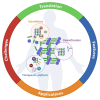Biomedical Metal-Organic Framework Materials: Perspectives and Challenges
- PMID: 39726715
- PMCID: PMC7617264
- DOI: 10.1002/adfm.202308589
Biomedical Metal-Organic Framework Materials: Perspectives and Challenges
Abstract
Metal-organic framework (MOF) materials are gaining significant interest in biomedical research, owing to their high porosity, crystallinity, and structural and compositional diversity. Their versatile hybrid organic/inorganic chemistry endows MOFs with the capacity to retain organic (drug) molecules, metals, and gases, to effectively channel electrons and photons, to survive harsh physiological conditions such as low pH, and even to protect sensitive biomolecules. Extensive preclinical research has been carried out with MOFs to treat several pathologies and, recently, their integration with other biomedical materials such as stents and implants has demonstrated promising performance in regenerative medicine. However, there remains a significant gap between MOF preclinical research and translation into clinically and societally relevant medicinal products. Here, we outline the intrinsic features of MOFs and discuss how these are suited to specific biomedical applications like detoxification, drug and gas delivery, or as (combination) therapy platforms. We furthermore describe relevant examples of how MOFs have been engineered and evaluated in different medical indications, including cancer, microbial, and inflammatory diseases. Finally, we critically examine the challenges facing their translation into the clinic, with the goal of establishing promising research directions and more realistic approaches that can bridge the translational gap of MOFs and MOF-containing (nano)materials.
Keywords: biomedicine; metal-organic frameworks; metallotherapy; nanoparticles; porous materials.
Figures





Similar articles
-
Mitigating Metal-Organic Framework (MOF) Toxicity for Biomedical Applications.Chem Eng J. 2023 Sep 1;471:144400. doi: 10.1016/j.cej.2023.144400. Epub 2023 Jun 25. Chem Eng J. 2023. PMID: 39280062 Free PMC article.
-
Metal-Organic Framework in Pharmaceutical Drug Delivery.Curr Top Med Chem. 2023;23(13):1155-1170. doi: 10.2174/1568026623666230202122519. Curr Top Med Chem. 2023. PMID: 36733193
-
Biomedical Applications of Metal-Organic Frameworks for Disease Diagnosis and Drug Delivery: A Review.Nanomaterials (Basel). 2022 Jan 16;12(2):277. doi: 10.3390/nano12020277. Nanomaterials (Basel). 2022. PMID: 35055294 Free PMC article. Review.
-
Metal-Organic Framework-Based Engineered Materials-Fundamentals and Applications.Molecules. 2020 Mar 31;25(7):1598. doi: 10.3390/molecules25071598. Molecules. 2020. PMID: 32244456 Free PMC article. Review.
-
Bibliometric and visualized analysis of metal-organic frameworks in biomedical application.Front Bioeng Biotechnol. 2023 May 10;11:1190654. doi: 10.3389/fbioe.2023.1190654. eCollection 2023. Front Bioeng Biotechnol. 2023. PMID: 37234479 Free PMC article.
Cited by
-
Artificial Intelligence Paradigms for Next-Generation Metal-Organic Framework Research.J Am Chem Soc. 2025 Jul 9;147(27):23367-23380. doi: 10.1021/jacs.5c08214. Epub 2025 Jun 24. J Am Chem Soc. 2025. PMID: 40551706 Free PMC article. Review.
-
Climate friendly MOFs synthesis for drug delivery systems by integrating AI, intelligent manufacturing, and quantum solutions in industry 6.0 sustainable approach.Toxicol Res (Camb). 2025 Jan 22;14(1):tfaf011. doi: 10.1093/toxres/tfaf011. eCollection 2025 Feb. Toxicol Res (Camb). 2025. PMID: 39850662 Review.
-
MOF-74 Nanofibers as an Advanced Porous Material for Air-Bearing Technology.Small. 2025 Aug;21(33):e2411108. doi: 10.1002/smll.202411108. Epub 2025 Jul 2. Small. 2025. PMID: 40605418 Free PMC article.
-
Metal-organic framework-based delivery systems as nanovaccine for enhancing immunity against porcine circovirus type 2.Mater Today Bio. 2025 Mar 27;32:101712. doi: 10.1016/j.mtbio.2025.101712. eCollection 2025 Jun. Mater Today Bio. 2025. PMID: 40230641 Free PMC article.
-
Recent Advancements in Metal-Organic Framework-Based Microfluidic Chips for Biomedical Applications.Micromachines (Basel). 2025 Jun 24;16(7):736. doi: 10.3390/mi16070736. Micromachines (Basel). 2025. PMID: 40731645 Free PMC article. Review.
References
LinkOut - more resources
Full Text Sources
Miscellaneous
